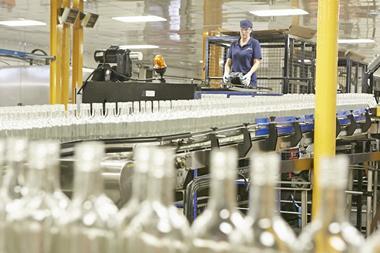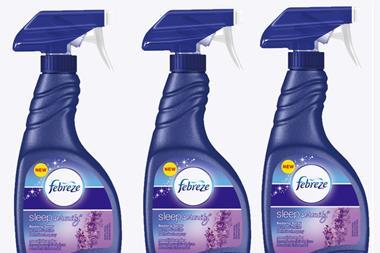Glass is on the ropes. Take the milk bottle. Back in 1975, 94% of milk was purchased (or delivered) in glass bottles. But according to dairy Crest, when it announced plans to close its last remaining glass milk bottle plant last year, that 94% had shrunk down to just 4% today.
The reason for the dramatic decline? Plastic. Today, milk is almost wholly sold in plastic containers. More than 275,000 tonnes of the stuff is used each year in the UK, the equivalent of 15 million bottles every single day, according to the Guides Network.
“Plastics offer a considerably lower weight than glass, and therefore equal much less transport energy in the lifecycle of any given product”
And it’s not just milk bottles. The polymer onslaught is apparent in every supermarket aisle, with fruit, vegetables, dairy, bread, meat, sauces, cereals and more packaged up in multiple layers of plastic, ready to be carried home in a plastic bag. So why is it so successful? Does this plastic domination mean the decline of glass is inevitable? Or can it fight back?
No one doubts that plastic is a formidable opponent. Even though it’s omnipresent in the supermarket aisle it’s hungry for more - the Guides Network say it’s growing by 4% in Western Europe every year. And that’s a brilliant thing, say advocates.
“Plastic packaging means less waste, less energy, fewer resources, less cost and the lowest environmental impacts,” says Sukhraj Poonia, research and communications manager at the Packaging & Films Association. “In relation to food contact packaging, plastic has made great strides in protecting the food of the consumer in transit, in-store and at home. Compared with other materials, it is the most versatile, cost-effective and environmentally friendly.”
It’s a stance that retailers and brands seem more than happy to adopt, with marked shifts from glass to plastics in key household products. And those shifts aren’t just for the reasons Poonia highlights.
Added value
Convenience, functionality and adaptability are also lauded as huge drivers of this growth. Plastic can also be moulded, extruded, cast and blown into seemingly limitless shapes, films or foams, assisting with ambitious packaging for increasingly innovative designers. It’s also squeezy. And that means squeezable bottles of sauces like Heinz tomato ketchup (it introduced a super lightweight bottle in the UK in 2009 claiming it would save 340 tonnes of plastic) are now widely available.
“You have to consider that plastic is made from oil, which is a very carbon intensive process. You have to look at the full life cycle”
“Consumers wanted something that added a bit more value to get every last bit, rather than having to shake the bottle or tap it on the bottom,” says Judith Allan of design agency Jones Knowles Ritchie. Indeed, six months after it was launched, Heinz redesigned the bottle to make it even squeezier, so customers could get every last drop.
Plastic’s lightweight structure is more than just convenient for consumers, however. It’s safer, too. “If you drop plastic the worst is that it might split but if it’s glass it can cut you” says Cirio brand manager, Clive Davies.
Cirio recently switched from glass to PET (polyethylene terephthalate) bottles (see box, left). The appearance of PET has come a long way since it was introduced to the fmcg market in the 1970s, says Davies. “You can get a nice, premium look to PET now, we’ve gone away from that cheap soda pop image.” Davies believes that though it’s taking time for consumers to come around to the idea of their favourite glass-packaged products starting to appear in plastic, the fact that other premium items, like olive oil, are also making the switch means it’s dawning on consumers that it doesn’t equate to a drop in quality.
Added value
Perhaps the bottom line is how much money Cirio is saving as a result of making the swap from glass to PET. “Packaging design on plastic is possible at a fraction of the cost,” says Davies. “And retailers are always looking for added value. Everybody is looking at their supply costs, and shipping glass around is a heavy job.”
Mike Maxwell, operations director at plastic recycler Jayplas agrees, saying: “Plastics offer a considerably lower weight than glass, and therefore equal much less transport energy in the full life cycle of any given product.”
He argues these lower supply chain costs allow savings to feed through to brands, retailers and customers, as well as fewer carbon emissions damaging the environment.
“We are a premium brand with a premium product and price point. And the consumer sees glass as premium packaging”
“Absolute rubbish,” says Sharon Crayton, head of marketing at Glass - Europe, for Ardagh, who finds a continued focus on weight in determining environmental impact a “completely blinkered” approach. Emissions from transportation represent just a fraction of the whole, she says. And glass’s corner has plenty more to shout about besides the environment.
A recent survey suggests that not only have consumers never stopped loving glass, they are starting to miss it, too. According to a recent poll of 8,000 people carried out by InSites Consulting last year, 87% of respondents rated glass as their number one packaging choice for food or drink, a rise of 13% compared with 2013 results.
“In all the work we have done with the Friends of Glass, and our own research, a genuine passion for glass packaging exists among consumers,” says Crayton. “They really love glass, and they will happily tell you that. The same thing doesn’t apply with plastic. Consumers see plastic as a necessary evil in their lives.”
Certainly plastic hasn’t had the most positive press of late. Research published in the journal PLOS One, which looked at the levels of plastic polluting the world’s oceans, claimed there is a minimum of 5.25 trillion plastic particles floating around, most of them ‘micro plastics’ measuring less than 5mm. The media is awash with disturbing images of the damage to wildlife and marine life: in December, for example, images of a dead albatross, cut open to reveal a stomach overflowing with plastic, hit the national press.
Consumer mistrust of plastic is further fuelled by the trickiness of recycling it. Crayton says it’s “very complex” as it’s necessary to keep the different types separate. And even if you only had one it would still be a problem, as PET can “only be recycled four or five times” before the material is no longer re-usable.
By contrast, according to the British Glass Manufacturers Confederation, glass is 100% recyclable and can be recycled an “infinite number of times without loss of quality, strength and functionality”.
In addition, its supporters insist glass offers just as many practical advantages as plastic, citing its simplicity, its inertness - meaning there is therefore no taste or odour transfer between product and container - and its durability.
Muscle
Glass has financial muscle, too, contributing £1.3bn in value to the UK economy, with a resurgence in people looking to make their preserves in glass jars at home and continued growth in demand for wine, spirits, beers and premium soft drinks. Lynn Sidebottom, at UK glass packaging manufacturer Beatson Clark, says glass gives products a “high-quality feel, which cannot be achieved using plastic or cardboard packaging.”
Amanda Grabham, marketing director for soft drinks at SHS, which produces adult soft drink Bottle Green, says glass is “fundamental to the positioning of the brand, and the way the consumer uses the products. Glass is our focus. We’re a premium brand with a premium product and price point. And the consumer sees glass as premium packaging.”
Though PET has “clearly come far” it still has a “long way to go until it has the table top acceptability of glass,” she adds.
Even on the issue of weight, glass manufacturers are making progress, achieving a 40% reduction in the weight of glass containers compared with 20 years ago, a positive and necessary move Crayton says was driven by “efficiency, economy, and sustainability.”
Whichever side you are on, it’s clear plastic has given glass one hell of a beating over the past couple of decades. But it’s also true that plastic is still some way from landing that all-important knockout blow - and that glass is still more than capable, and willing, to keep on fighting its corner.
paper packaging
Of course, it isn’t just a two-player game, and not to be left behind in sustainable strides forward are fibre-based materials, paper and cardboard. For these, the advantage of being 100% biodegradable is often overshadowed by the vast resultant deforestation.
In an attempt to combat such an environmental impact, Unilever, a significant user of paper and cardboard packaging for its numerous brands, has identified combating the threats of deforestation as one of the three key goals within its sustainable sourcing programme.
As a result it has committed to sourcing 75% of its paper and board, used in packaging, from certified, sustainably managed forests, or recycled material by 2015, and 100% by 2020.
In 2013, it also finalised its aim to achieve ‘sustainable primary packaging’ for its Dove soap bars, which are now from schemes that are FSC-certified in Latin America, and PEFC-certified in North America.
It’s a response to consumer demands for sustainability within fibre-based packaging, like those used by premium ready meal Charlie Bigham’s (above), whose packaging is created by a small French business that uses sustainable wood, or snack box firm Graze, which actively promotes the light weight of the cardboard packaging it delivers, and adds that all the material is sourced from sustainable forests.
Waste management company Veolia is looking to innovate even further. Last year it announced a £1m investment to transform non-recyclable paper, due to contamination or poor quality, into a pulp called Pro-Fibre that can then be re-used in packaging products. “Not only will this benefit the circular economy, it will also help Veolia increase recycling rates across the UK,” says Forbes McDougall, head of circular economy at the company.
The Cirio switch
A launch of what Cirio claims is the UK’s first PET-packaged passata is going “great guns”, according to brand manager, Clive Davies.
The brand announced in November 2012 that it would switch from glass to plastic for its La Classica and Napoletana passata in 540g PET bottles, after research showed it had the visual cues of glass, but was a lighter, tougher alternative.
“Retailers are always looking for added value, everybody is looking at their supply costs, and shipping glass around is a heavy job,” says Davies.
“You can get a nice, premium look to PET now; we’ve gone away from that cheap soda pop image.”
Packaging design on plastic is also possible at a “fraction of the cost” of glass, while Davies cites health and safety as an additional factor.
“If you drop plastic the worst is that it will split, if its glass it can cut you,” he adds.
The brand manager believes it’s taking time for consumers to come around to the idea of their favourite glass-packaged products now in plastic, but with traditional items, such as olive oil, now moving to plastic options there’s a dawning realisation that it doesn’t have to mean a drop in quality.








No comments yet